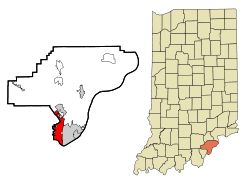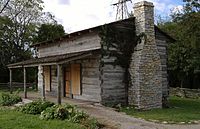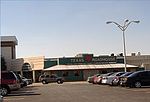- Clarksville, Indiana
-
Town of Clarksville — Town — Clarksville Town Hall Location in the state of Indiana Coordinates: 38°18′43″N 85°46′2″W / 38.31194°N 85.76722°WCoordinates: 38°18′43″N 85°46′2″W / 38.31194°N 85.76722°W Country United States State Indiana County Clark Townships Silver Creek, Jeffersonville Government – Type Town Council – President Paul Kraft Area – Total 10.2 sq mi (26.4 km2) – Land 10.1 sq mi (26.1 km2) – Water 0.1 sq mi (0.2 km2) Elevation 456 ft (139 m) Population (2010) – Total 21,724 – Density 2,120.9/sq mi (818.9/km2) Time zone EST (UTC-5) – Summer (DST) EDT (UTC-4) ZIP codes 47129 Area code(s) 812 FIPS code 18-12934[1] GNIS feature ID 0432578[2] Website http://townofclarksville.com/ Historical populations Census Pop. %± 1880 1,037 — 1890 1,692 63.2% 1900 2,370 40.1% 1910 2,743 15.7% 1920 2,322 −15.3% 1930 2,243 −3.4% 1940 2,386 6.4% 1950 5,905 147.5% 1960 8,088 37.0% 1970 13,298 64.4% 1980 15,164 14.0% 1990 19,833 30.8% 2000 21,400 7.9% 2010 21,724 1.5% Source: US Census Bureau Clarksville is a town in Clark County, Indiana, United States, along the Ohio River as a part of the Louisville Metropolitan area. The population was 21,724 at the 2010 census. The town, once a home site to George Rogers Clark, was founded in 1783 and is the oldest American town in the Northwest Territory. The town is home to the Colgate clock, one of the largest clocks in the world and the Falls of the Ohio State Park, a large fossil bed.
Contents
History
Clarksville is named for American Revolutionary War General George Rogers Clark, who lived for a time on a point of land on the Ohio River. Founded in 1783, the town is believed to be the first American settlement in the Northwest Territory of the new United States.
The site was first used as a base of operations by Clark during the American Revolution. In 1778 he established a post on an island at the head of the Falls of the Ohio. From there he trained his 175-man regiment for the defense to the west. After the war, Clark was granted a tract of 150,000 acres (610 km2) for his services in the war. In 1783 1,000 acres (4 km2) were set aside for the development of a town, Clarksville. The same year a stockade was built and settlement began.[3]
The explorer William Clark was a younger brother of George Rogers Clark. Renowned historian Stephen Ambrose writes of Meriwether Lewis and William Clark in Undaunted Courage, "When they shook hands [at Clarksville], the Lewis and Clark Expedition began." A two-figure statue near the falls commemorates the expedition. Several localities other than Clarksville claim precedence for the start of the Lewis and Clark Expedition, most notably St. Louis, Missouri.[4]
Due to the many floods in the nineteenth century and the Indiana Canal Company's failed competition to build a canal around the Ohio Falls, the town struggled. On Aug. 24 1805 the Indiana Territorial Legislature authorized the construction of a canal around the Falls of the Ohio at Clarksville. The first attempt failed and the investors lost their money. Historians believe it was used to finance the conspiracy of Aaron Burr. Developers tried to build a canal in 1817 and again in 1820. But the race to build the canal was lost in 1826 when the federal government made a large grant to build the Louisville and Portland Canal. The lack of a canal handicapped the growth of the town as the Falls of the Ohio made river transport from the city difficult.[5]
Clarksville became a popular dueling spot for Kentuckians who wanted to dodge Kentucky's anti-dueling laws. The most famous of these was the 1809 duel between Henry Clay and Humphrey Marshall. [6] There was an attempt to build a second town within Clarksville's boundaries, named Ohio Falls City, until the Indiana Supreme Court ruled that this would be illegal.
The town was managed by a ten-member Board of Trustees in the charter from Virginia.[4] The trustees were allowed to align lots along roads and sell the lots for the proceeds to benefit the town. The trustees could elect replacements as needed and did not have to reside in the town. This remained controversial with residents until 1889 when the board stopped meeting and was replaced by a three-member board. One member was selected by the Floyd County Commissioners, one by the Clark County Commissioners, and one by residents of Clarksville. Between 1889 and 1937, the town established a five-member board entirely elected by residents. The historic records related to this governmental change were lost in the Ohio River flood of 1937.[4]
The Great Flood of 1937 decimated the town. The entire town was submerged beneath as much as 12 feet (3.7 m) of water in some areas for over three weeks during January and February. With almost all of the old town destroyed, Clarksville was rebuilt with a new modern city plan.
The post-World War II housing boom and new jobs brought growth to the city. The population has increased from 2,400 in 1940 to 22,000 in 2000. The city has expanded to the north by annexing several sizable suburbs. By 1981 the State of Indiana changed statutes to convert the managing board of trustees to a council with members rather than trustees. In 1990 voters approved expansion of members of the Town Council from five to seven following the area growth.[4]
Geography
Clarksville is located at 38°18′43″N 85°46′2″W / 38.31194°N 85.76722°W (38.311885, -85.767265)[7].
According to the United States Census Bureau, the town has a total area of 10.2 square miles (26 km2), of which, 10.1 square miles (26 km2) of it is land and 0.1 square miles (0.26 km2) of it (0.79%) is water.
Demographics
As of the census[1] of 2000, there were 21,400 people, 8,984 households, and 5,561 families residing in the town. The population density was 2,120.6 people per square mile (818.9/km²). There were 9,537 housing units at an average density of 945.1 per square mile (364.9/km²). The racial makeup of the town was 90.56% White, 5.59% African American, 0.27% Native American, 0.93% Asian, 0.03% Pacific Islander, 1.08% from other races, and 1.53% from two or more races. Hispanic or Latino of any race were 2.80% of the population.
There were 8,984 households out of which 28.4% had children under the age of 18 living with them, 44.4% were married couples living together, 13.3% had a female householder with no husband present, and 38.1% were non-families. 31.6% of all households were made up of individuals and 13.2% had someone living alone who was 65 years of age or older. The average household size was 2.32 and the average family size was 2.92.
In the town the population was spread out with 23.1% under the age of 18, 9.9% from 18 to 24, 29.8% from 25 to 44, 22.0% from 45 to 64, and 15.2% who were 65 years of age or older. The median age was 36 years. For every 100 females there were 91.1 males. For every 100 females age 18 and over, there were 87.8 males.
The median income for a household in the town was $35,473, and the median income for a family was $44,688. Males had a median income of $30,860 versus $23,329 for females. The per capita income for the town was $20,315. About 5.6% of families and 8.1% of the population were below the poverty line, including 10.5% of those under age 18 and 6.7% of those age 65 or over.
Attractions
Clarksville has the largest exposed fossil beds from the Devonian period. This area has now been incorporated in the Falls of the Ohio State Park, where the state has built an education center. The fossils include plant and marine life from a prehistoric coral reef that are 386 million-years-old.[8]
Several other local parks included sports fields, such as the 332-acre (1.3 km2) Lapping Park, which contains a golf course, soft ball field, shelter house, amphitheater, and hiking trails.[9]
The city has the "7th largest clock in the world", at the former Colgate-Palmolive Plant near the Ohio River. Many locals still mistakenly claim it as the "2nd largest clock in the world", but it was surpassed years ago. As the Colgate company closed the plant in early 2008, the clock's future was in question. The town has vowed to keep the clock in its current location, which can be seen from across the river at downtown Louisville, Kentucky.
The Clarksville Little Theater is one of the oldest continuously running community theaters in the United States. Also located here is Derby Dinner Playhouse, the only dinner theater in the area.[10]
The restaurant chain Texas Roadhouse originated here, and it has kept an outlet at its original location in the Green Tree Mall. Clarksville is also the home of the nation's second largest Bass Pro at the River Falls Mall.
Notable natives and residents
- John James Audubon spent considerable time here, as he made many of his bird fieldbook sketches at the Falls of the Ohio.[4]
- Frank Kimmel, a NASCAR driver, was born and lives in Clarksville.
Twin cities
The Clarksville sister or twin city program began in 1998. Bewdley and Melton Mowbray in the UK were the first sister cities to begin friendship ties in 1998 and 1999 and relations have continued.[11] Most recently La Garenne-Colombes in Paris urban area, France joined the sister cities of Clarksville.[12]
Gallery
See also
- List of cities and towns along the Ohio River
- Clarksville Senior High School
- Clarks Hill, Indiana, a community in Tippecanoe County originally named Clarksville
- John Minta
References
- ^ a b "American FactFinder". United States Census Bureau. http://factfinder.census.gov. Retrieved 2008-01-31.
- ^ "US Board on Geographic Names". United States Geological Survey. 2007-10-25. http://geonames.usgs.gov. Retrieved 2008-01-31.
- ^ Jane Sarles, Clarksville, Indiana, p. 9
- ^ a b c d e "Town of Clarksville:Pre-History & History". Archived from the original on 2008-02-11. http://web.archive.org/web/20080211183510/http://town.clarksville.in.us/history.html.
- ^ Ralph D. Gray, Indiana History, p. 123
- ^ Henry Clay, By Thomas Hart Clay, Ellis Paxson, Pg 50
- ^ "US Gazetteer files: 2010, 2000, and 1990". United States Census Bureau. 2011-02-12. http://www.census.gov/geo/www/gazetteer/gazette.html. Retrieved 2011-04-23.
- ^ "Welcome to the Falls of the Ohio". Fallsoftheohio.org. http://www.fallsoftheohio.org/. Retrieved 2009-07-13.
- ^ "Town of Clarksville's Parks". Clarksvilleparks.com. Archived from the original on 2008-06-11. http://web.archive.org/web/20080611151117/http://www.clarksvilleparks.com/parks10.html. Retrieved 2009-07-13.
- ^ "Town of Clarksville: Information". Archived from the original on 2007-08-10. http://web.archive.org/web/20070810011503/http://town.clarksville.in.us/info.html.
- ^ "Town of Clarksville: Sister City Information". Archived from the original on 2007-08-19. http://web.archive.org/web/20070819084911/http://town.clarksville.in.us/sistercities/short_history.html.
- ^ Welcome to the Town of Clarksville
External links
- Town of Clarksville, Indiana website
- Clarksville Sister Cities
- Clarksville Parks Department
- "Clarksville Historical Society". Archived from the original on 2006-10-06. http://web.archive.org/web/20061006190053/http://town.clarksville.in.us/historicalsociety/.
Municipalities and communities of Clark County, Indiana Cities Towns Townships Bethlehem | Carr | Charlestown | Jeffersonville | Monroe | Oregon | Owen | Silver Creek | Union | Utica | Washington | Wood
Unincorporated
communitiesArctic Springs | Bennettsville | Bethlehem | Blue Lick | Broom Hill | Carwood | Cementville | Hamburg | Henryville | Hibernia | Longview Beach | Marysville | Memphis | Nabb | New Liberty | New Market | New Washington | Oak Park | Otisco | Otto | Owen | Perry Crossing | Prather | River Ridge | Rolling Hills | Runyantown | Speed | Starlight | Sunset Village | Underwood | Vesta | Watson | Wilson
Louisville, Kentucky • Portal Subject areas Attractions/Events • Cityscape • Economy • Education • Geography • Government • History • Media • Neighborhoods • Parks • People • Performing arts • Sports • Transportation
Top subjects National
Historic
LandmarksProminent suburbs
(over 10K pop.)Bardstown • Clarksville • Jeffersontown • Jeffersonville • Mount Washington • New Albany • St. Matthews • Shelbyville • Shepherdsville • ShivelyCategories:- Clarksville, Indiana
- Towns in Indiana
- Lewis and Clark Expedition
- Populated places established in 1783
- Louisville metropolitan area
- Populated places in Clark County, Indiana
Wikimedia Foundation. 2010.









